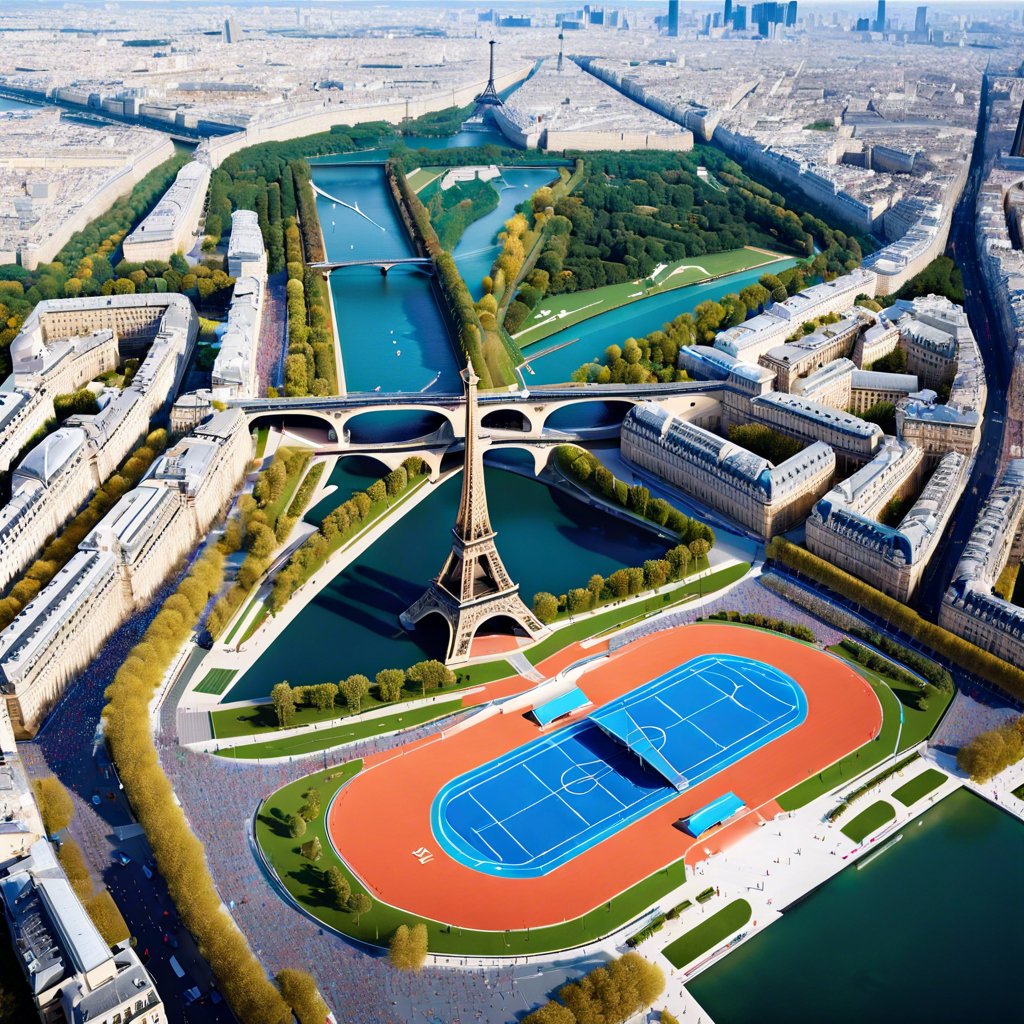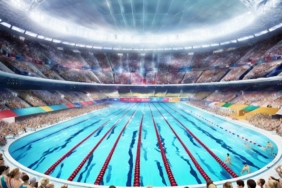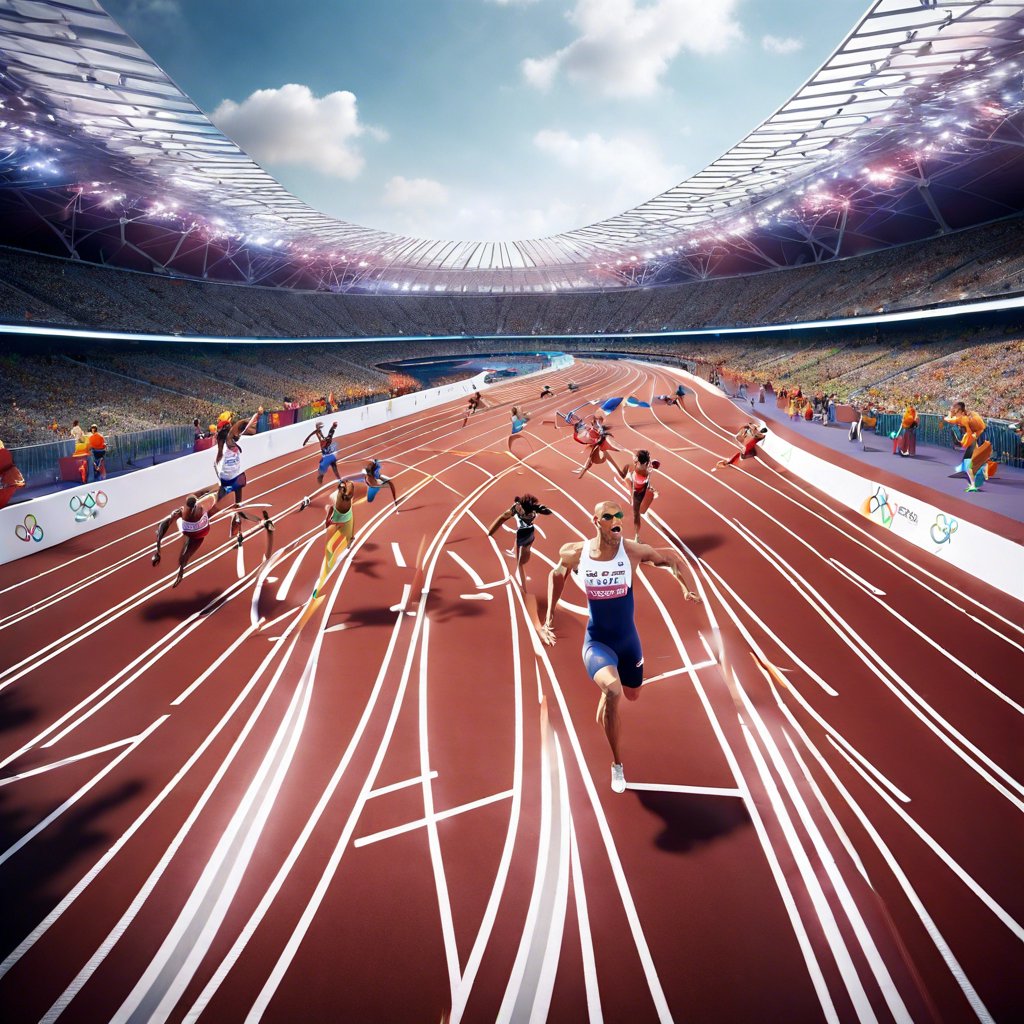The Quest for a Fast and Unique Track at Stade de France for the 2024 Paris Olympics
As the 2024 Paris Olympics approach, the Stade de France faces two critical requirements for its track: it must be painted purple and engineered for speed. The choice of color reflects a desire to create a distinctive and visually stunning environment for athletes, departing from the traditional red tracks. This innovative hue follows the trend set by the 2016 Rio de Janeiro Olympics, where the track was navy blue, marking a shift in Olympic aesthetics.
However, the goal of creating a “fast track” is not merely a design whim. The term “fast track” has become somewhat clichéd in athletics; after all, no host city would ever request a slow one. Yet, the Paris track has indeed proven to be remarkably fast, with seven Olympic records and three world records established during the Games. It’s worth noting that this tally excludes outstanding decathlon performances and field events, such as the hammer throw and shot put, which do not utilize the runway or the track.
In recent years, the trend of record-breaking performances has been on the rise: five records were set in London (2012), six in Rio (2016), ten in Tokyo (2020), and once again, ten in Paris. While it may be tempting to attribute this solely to athletes becoming bigger, faster, and stronger, the increasing sophistication of technology and training methodologies also plays a crucial role.
Track and Field Olympic/World Records Set in Paris 2024
| Athlete(s) | Event | Nation | Record |
|---|---|---|---|
| Team USA | 4x400m Mixed Relay | USA | World Record |
| Joshua Cheptegei | 10,000m | Uganda | Olympic Record |
| Mondo Duplantis | Pole Vault | Sweden | World Record |
| Cole Hocker | 1,500m | USA | Olympic Record |
| Winfred Yavi | 3,000m Steeplechase | Bahrain | Olympic Record |
| Arshad Nadeem | Javelin | Pakistan | Olympic Record |
| Sydney McLaughlin-Levrone | 400m Hurdles | USA | World Record |
| Marileidy Paulino | 400m | Dominican Republic | Olympic Record |
| Faith Kipyegon | 1,500m | Kenya | Olympic Record |
| USA Men’s Team | 4x400m | USA | Olympic Record |
Records were not just broken in Paris; they were shattered. A staggering thirteen male athletes outperformed Kenenisa Bekele’s 10,000m Olympic record from 2008 (27:01), with Uganda’s Joshua Cheptegei clinching victory in an astonishing 26:43. Similarly, four men broke Jakob Ingebrigtsen’s 1,500m Olympic record from Tokyo, with Ingebrigtsen himself finishing without a medal. In the women’s category, four women surpassed Faith Kipyegon’s 1,500m Olympic record, with Kipyegon ultimately winning the event in a remarkable 3:51.
The women’s 400m final set a new standard, with all nine athletes finishing under 50 seconds, while the men’s 100m final was unprecedented in its competitiveness. It marked the first time that a sub-10 second semi-final did not guarantee a place in the final. The final race itself was historic, as all nine competitors finished under 10 seconds in a wind-legal race, with only a 0.12-second margin separating gold medalist Noah Lyles from Oblique Seville, who took eighth place.
Moreover, the men’s 800m final witnessed a historic first: four men ran under 1:42 in a single race, even though the Olympic record was not broken. This illustrates the extraordinary caliber of competition at the Games.
The Science Behind Fast Tracks
Maurizio Stroppiana, vice president of Mondo, an Italian company renowned for its synthetic athletics tracks, shares insights into the evolution of track technology. Mondo has been at the forefront of track manufacturing since the first Olympic track was created for Moscow in 1980, twelve years after synthetic tracks were introduced at the 1968 Mexico City Olympics. Since 1992, Mondo has produced every Olympic track.
“Mondo tracks are recognized as the fastest in the world, boasting over 300 records to date and accounting for more than 70 percent of all current records,” explains Stroppiana. While this impressive statistic suggests that Mondo has mastered the art of crafting fast tracks, the science behind it is more complex than one might assume. The tracks are composed of “vulcanized rubber,” which provides unique properties beneficial to athletes.
Reflecting on the history of Olympic tracks, Stroppiana notes that during the 1924 Paris Olympics, the track was made of cinders. “It was akin to running on dirt,” he recounts. “Not only did it get dirty, but running on it felt more like traversing a field than a proper 400m track.”
The term “fast tracks” can be misleading; it’s not merely about the surface but about optimizing efficiency. “Our goal is to minimize energy loss,” explains Stroppiana. “When an athlete’s foot strikes the track, it compresses, and we aim to ensure that energy is returned in the most efficient way possible, although some energy will inevitably be lost.”
When running, athletes generate approximately three times their body weight in vertical force. How effectively this force translates into horizontal movement depends on the “braking and propulsive forces” involved. Mondo has introduced “elliptical air cells within the base layer of the track,” leading to a 2.6 percent increase in net horizontal energy return and a 1.9 percent enhancement in shock absorption.
Striking a balance between protecting athletes and maximizing performance is crucial, as these factors are intricately linked. “The track must provide a certain level of comfort and cushioning,” Stroppiana states. He elaborates that the key determinants of maximal energy return include “the type of material and the material’s elasticity.” Mondo employs aerosols on the track’s underside to enhance cushioning and optimize energy return.
“In our previous track (Tokyo), we observed that depending on where an athlete placed their foot, the results varied. We modified the shape to ensure a more uniform response, increasing the area of the track that depresses underfoot,” Stroppiana explains. “This enhancement guarantees that athletes do not experience any noticeable difference; the elastic response remains consistent throughout the track, allowing them to maintain their rhythm.”
While this may sound straightforward, the process is far from simple. “It took us about two years to fine-tune this new solution,” Stroppiana reveals. “We developed a mathematical model at the University of Milan, which allows us to run simulations and test new combinations more efficiently.” The four-year Olympic cycle provides ample time for preparation.
One common misconception Stroppiana wishes to dispel is the idea that track hardness equates to speed. “This narrative began after the 1996 Atlanta Olympic Games, where numerous records were set,” he notes. “Since then, it’s been challenging to alter that perception.” He elaborates on the softness of the Paris track, stating, “It is softer than before. We’ve learned that a hard track is not necessarily beneficial for performance; in fact, it can lead to injuries. Over the last six or seven years, we have adjusted our approach.”
Mondo has also adopted lower-carbon production methods and more sustainable materials, incorporating calcium carbonate derived from mussel shells in their manufacturing process. Unsurprisingly, creating such advanced tracks comes at a cost. Stroppiana estimates the price of the Paris track to be “between two to three million,” emphasizing that the top synthetic layer is only 14 millimeters thick. Typically, tracks have a lifespan of around 15 years before requiring replacement or relaying.
Decades of academic research have explored the effects of altitude on athletic performance—beneficial for sprints due to reduced air resistance, but detrimental for distance running because of lower oxygen availability. The 1968 Olympics marked the highest-altitude summer Games ever held, at over 2,000 meters (7,000 feet), where sprinting and jumping records were obliterated, while distance races suffered.
For sprint performances, records over 1,000 meters are classified as ‘altitude-assisted’, and sprints with a following wind exceeding two meters are deemed non-legal. This underscores the importance of an optimal location for a track to facilitate record-breaking performances. Saint-Denis, where the Stade de France is located, is just 50 meters above sea level. Stroppiana notes that the stadium creates a “microclimate” conducive to enhanced performance conditions.
Stroppiana explains, “The stadium’s design, featuring an oval shape and partially covered roof, helps to mitigate wind interference. The arrangement of the seating and the height of the stands contribute to shielding the track.” Looking to the future, both the 2028 Games in Los Angeles and the 2032 Games in Brisbane are set in coastal cities, which may offer similar advantages.
Stroppiana is optimistic about future innovations in track-making, particularly through collaboration with shoe and spike brands, who have traditionally been “secretive about their own insights.” He notes, “There is a growing movement toward open innovation, which encourages collaboration within the industry rather than competition.”
“I believe the next evolution of track surfaces will involve adjustments tailored to different field disciplines,” he adds, hinting at potential improvements for future events. Mondo collaborates with brands like Adidas, Nike, Asics, ON, and Puma, having worked closely with Puma for the Paris track.
“Before Tokyo, we partnered with Asics, allowing them to test various track solutions at our facility. They evaluated different types of materials to determine the best fit,” Stroppiana explains. “They focus on optimizing the interaction between the track and spikes, which is crucial for performance.”
Different events necessitate varying spike lengths. Stroppiana explains that 400m spikes possess distinct properties on the right side to assist athletes during bend running. The challenge lies in achieving the right balance: “We strive to ensure proper traction while minimizing friction. If spikes penetrate the surface too deeply, it can slow athletes down,” he notes. “This characteristic of the top wear layer must ensure spike resistance.”
Exceptions exist for pole vault and javelin, where athletes exert immense force and require spikes to penetrate the surface for safety. “In Paris, if you closely observe the javelin runway, you’ll notice that the last section has a slightly different color than the track,” reveals Stroppiana. “This was engineered specifically for javelin throwers. We collaborated with the German and Finnish teams to test various solutions.” They aimed to create a runway that offered “greater spike resistance and enhanced grip.”
“Typically, tracks must maintain uniformity; variations in properties for different areas are not allowed. However, for javelin, these adjustments were accepted by World Athletics.” The results were impressive: Pakistan’s Arshad Nadeem shattered the Olympic record by over 2.5 meters, launching the javelin to an astounding 92.97 meters, securing Pakistan’s first gold medal in athletics.
Stroppiana’s vision for the future includes even more tailored adjustments. “For long-distance events, we could create specialized sections, perhaps an inner lane,” he suggests, mentioning that they have experimented with tracks designed solely for training—though not for competition—featuring differentiated elastic responses.
As the countdown to the 2028 Games in Los Angeles begins, Mondo has four years to refine and test new combinations alongside shoe brands. The lingering question remains: what color will the track be?
(Top photo: Nathan Laine/Bloomberg via Getty Images)


















